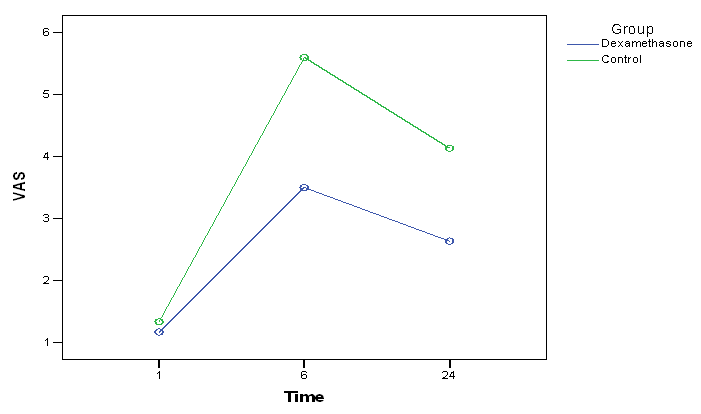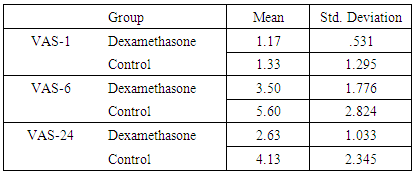-
Paper Information
- Paper Submission
-
Journal Information
- About This Journal
- Editorial Board
- Current Issue
- Archive
- Author Guidelines
- Contact Us
Research in Obstetrics and Gynecology
p-ISSN: 2326-120X e-ISSN: 2326-1218
2017; 5(2): 21-23
doi:10.5923/j.rog.20170502.01

Effect of Preoperative Intravenous Dexamethasone on Duration of Analgesia after Spinal Anesthesia in Abdominal Surgeries
Mahnaz Narimani Zamanabadi1, Seyed Ahmad Seyedmehdi2, Narges Haghayegh Khorasani3
1Anestesiologist, Assistant Professor, Department of Anesthesiology, Bouali Hospital, Islamic Azad University, Tehran Medical Branches, Tehran, Iran
2Anesthesiologist, Fellowship of Intensive Care, Assistant Professor Department of Anesthesiology, Bouali Hospital, Islamic Azad University, Tehran Medical Branches, Tehran, Iran
3Researcher and General Physician, Iran
Correspondence to: Seyed Ahmad Seyedmehdi, Anesthesiologist, Fellowship of Intensive Care, Assistant Professor Department of Anesthesiology, Bouali Hospital, Islamic Azad University, Tehran Medical Branches, Tehran, Iran.
| Email: |  |
Copyright © 2017 Scientific & Academic Publishing. All Rights Reserved.
This work is licensed under the Creative Commons Attribution International License (CC BY).
http://creativecommons.org/licenses/by/4.0/

Objective: Most patients experience postoperative pain after surgery and dexametasone are strong anti-inflammatory agents can be used for postoperative pain control so this study was performed to determine the effect of preoperative intravenous dexamethasone on duration analgesia after spinal anesthesia in abdominal surgeries. Materials and methods: A double blind prospective randomized clinical trial was performed on 60 patients that candidate for elective lower abdominal surgery, they were randomly assigned into two group: Group A: received 8 mg dexametasone / IV 30 minutes before start surgery. Group B: Received 2 cc normal saline / IV 30 minutes before start surgery. In both groups pain based on VAS were recoreded in different time (1, 6 and 24 houres after operation and statistical methods is used. In past study the effect of dexametasone in postoperative pain of orthopedic surgery by spinal anesthesia were performed but a few research on the lower abdominal surgery were performed. Results: The results in this study revealed that there was significant difference between pain severities during first 24 hours after operation across the groups and the pain severity was less in dexamethasone group (P <.05). None of the patients in two groups had side effect. Conclusions: Totally, it may be concluded that dexamethasone is effective on postoperative analgesia duration in patients under abdominal surgery with spinal anesthesia.
Keywords: Abdominal Surgery, Dexamethasone, Pain
Cite this paper: Mahnaz Narimani Zamanabadi, Seyed Ahmad Seyedmehdi, Narges Haghayegh Khorasani, Effect of Preoperative Intravenous Dexamethasone on Duration of Analgesia after Spinal Anesthesia in Abdominal Surgeries, Research in Obstetrics and Gynecology, Vol. 5 No. 2, 2017, pp. 21-23. doi: 10.5923/j.rog.20170502.01.
1. Materials and Methods
- Study is conducted in double-blind randomized clinical trial and studied population is consisted of patients under abdominal surgery with spinal anesthesia. Sample size: total of 60 patients have been examined in two groups of 30 persons. Sampling method was convenience method. Sixty patients randomly assigned to Dexamethazone group received 8mg of dexamethazone /IV and placebo group received 2cc sterile water half hour before spinal anesthesia. Then duration of postoperative analgesia assed by VAS and pethidine consumption at 1, 6 and 24 hours after spinal anesthesia.Inclusion Criteria: 1. Approved by institutional Ethics Committee 2. Informed constant forma patient / don’t have history of drug of alcohol dependence / don’t have chronic pain. 3. Spinal anesthesia. 4. Lack of allergy to dexamethasone. 5. Elective abdominal Surgery. 6. ASA I and II. 7. BMI between 25 and 30, 8. People younger than 70 years old 9) 9.Surgery time less than 180 minutes.Exclusion Criteria: 1. cardiac, respiratory arrest, 2. Unusual bleeding. 3. Unexpected events such as damage to big arteries or vital organs like liver, intestine and spleen. 4. Patient hypoxia. 5. Unusual Prolongation of surgery operation. 6. Failure of cooperation of patient in participating in the study. Methodology: in this intervention study carried out in double-blind randomized clinical trial, after acquiring agreement of patients experiencing elective abdominal surgery operation with preparedness of spinal anesthesia for surgery operation, 30 patients received 8 mg intravenous dexamethasone half hour before surgery based on randomized numbers table and other 30 patients were injected 2 CC distilled water half hour before the surgery.All patients have ASA ( Americans Society of Anesthesia ) I – II, aged 19- 70 years and, Approved by institutional Ethics Committee, Informed constant forma patient / don’t have history of drug of alcohol dependence / don’t have chronic pain, Lack of allergy to dexamethasone, BMI between 25 and 30, without cardiac or respiratory arrest, unusual bleeding and Unexpected events such as damage to big arteries or vital organs like liver, intestine and spleen or Patient hypoxia and duration of surgery less than 180 minutes.The noninvasive monitoring include blood pressure, EKG, pulse rate, pulse oximetry was done for all the patients.All patients received serum Ringer 5 CC per kilogram in intravenous injection in pre induction time or ten minutes before drug injections. For the patients, in a sitting position in L3-L4 or L4-L5 space with spinal Quinke needle 25, Marcaine 0.5%, 2-2.5 CC regional anesthesia is conducted by anesthesiologist. After the patients experiences supine status and the level of anesthesia is checked out till T4, after performing surgery operation, the degree of pain has been evaluated in 1,6 and 24 hours after the surgery based on VAS pattern. Age range of patients was 18-65 years.Data collection: using checklists data are collected in a field manner, and tool of data collection was checklists. Data analysis: data analysis is done using SPSS 13 statistical software and average and SD have been recorded for quantitative variables and relative and absolute frequency was recorded for qualitative variables. Tests used in this study include Chi square and independent and Fischer t, while the level of significance was considered less than 0.05.Ethical considerations: all information derived from people and their name were kept confidential and results are published generally and by group, individual results are offered if necessary without mentioning name and individual information. Similarly, written consent of all patients is obtained and content of Helsinki Convention is observed.
2. Results
- Control and experiment groups are reviewed and compared in terms of patients age and they had no significant difference with each other and both were similar (P>0.05). Average age of control group 31.8 with SD of 12.6, and average age of experiment group with dexamethasone were 35.9 with SD of 14.2 with no difference.Weight of patients in control group was 79.7 kg with 6.5 kg SD and in dexamethasone group was 77.5 kg with 7.1 kg SD that the difference was not significant (P>0.05).Duration of surgery operation in experiment group was 66 minute with 16 min SD and it was 74 minute in dexamethasone and SD of 27 minute that the difference was not significant (P>0.05). As it is shown in table 1 and in figure 1, the intensity of pain based on VAS scale was the same at the beginning of study (P>0.05). However, in hour 6 (P=0.003) and hour 24 after surgery (P=0.001), the intensity of pain was significantly less in dexamethasone group.
|
 | Figure 1. Distribution of frequency of pain intensity based on VAS in two studied groups |
3. Discussion and Conclusions
- Various methods are available for reducing pain including regional analgesia that is epidural and spinal, and systemic analgesia methods like pain killers (Anesthetic or analgesia), NSAID like ibuprofen and Diclofenac etc or narcotics such as morphine, pethidine and methadone [4, 5], and each one have their own efficiency and side effects, therefore it is needed to carry out various studies for determining and comparing the extent of effectiveness of various methods to specify the method with maximum effectiveness and least side effect. For example, spinal anesthesia has better analgesic effect when compared with general anesthesia [5]. Yet, the same pain-killing effect also can be enhanced by adding other adjuvant medicines. Therefore, this study examines the effect of intravenous dexamethasone before surgery on the duration of analgesia after spinal anesthesia in abdominal surgery operations. {Obtained results in this intervention study shows that there is a significant difference between intensity of pain over 24 hours after surgery operation in two studied groups and the intensity of pain is less in dexamethasone group than placebo It means That usage of dexamethsone could decreased pain after surgery Similar to others pain-killer without any side effects has been observed in both groups. Banihashem et al in 2011 in Iran have studied 50 patients under surgery operation and a group has received 8 mg Dexamethasone and a group 2 CC normal saline. Results have shown that analgesia duration in dexamethasone group was 401.9 min with SD 72.4 min and in placebo group it was 202 min with SD 43.6 min, and it showed a statistically significant difference [7], and in our study this effectiveness has been observed better about dexamethasone. Jo et al in 2011 in South Korea have studied 90 patients with abdominal surgery and a group has received 5 mg dexamethasone before surgery and a group received it during the surgery, while another group didn’t received medication. Results showed that both group receiving dexamethasone had a good analgesia effect when compared to non-medication group [8], this underpins the findings obtained from our study. Kardash et al in 2008 in Canada have studied 50 patients under surgery and a group has received 40 mg dexamethasone and a group received normal saline, results showed that intensity of pain in dexamethasone group was 2.5 times less than normal saline [9], we also achieved relatively similar results in our study. Movafegh et al in 2007 in Iran studied 60 patients with surgery and a group has received 0.1 mg per kg dexamethasone and a group 2 CC normal saline and results showed that intensity of pain in dexamethasone group was less than normal saline group [10], which is consistent with results of our study.Tan et al in 2001 in Taiwan have studied 60 patients under surgery and a group has received 10 mg dexamethasone and a group has received normal saline. Results showed that intensity and duration of pain in dexamethasone and normal saline was the same [11] which is not consistent with our results and forgoing studies which is due to low power of the study. In sum, based on results of this study and comparing it with other studies in this respect, this conclusion can be drawn that dexamethasone has a significant effect on analgesia duration within patients under abdominal surgery operation with spinal anesthesia.However, at the end, it is recommended to further review the studies in this regard for underpinning obtained results in this study with bigger sample size and also reviewing and comparing other methods of pain reduction.
 Abstract
Abstract Reference
Reference Full-Text PDF
Full-Text PDF Full-text HTML
Full-text HTML